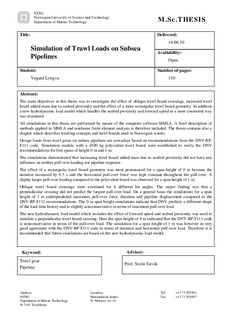| dc.contributor.author | Longva, Vegard | nb_NO |
| dc.date.accessioned | 2014-12-19T12:05:54Z | |
| dc.date.available | 2014-12-19T12:05:54Z | |
| dc.date.created | 2010-12-07 | nb_NO |
| dc.date.issued | 2010 | nb_NO |
| dc.identifier | 375164 | nb_NO |
| dc.identifier.uri | http://hdl.handle.net/11250/237797 | |
| dc.description.abstract | The main objectives in this thesis was to investigate the effect of oblique trawl board crossings, increased trawl board added mass due to seabed proximity and the effect of a more rectangular trawl board geometry. In addition a new hydrodynamic load model which handles the seabed proximity and forward speed in a more consistent way was examined.
All simulations in this thesis are performed by means of the computer software SIMLA. A brief description of methods applied in SIMLA and nonlinear finite element analysis is therefore included. The thesis contains also a chapter which describes trawling concepts and trawl boards used in Norwegian waters.
Design loads from trawl gears on subsea pipelines are nowadays based on recommendations from the DNV-RPF111 code. Simulation models with a 4500 kg polyvalent trawl board were established to verify the DNV recommendations for free spans of height 0 m and 1 m.
The simulations demonstrated that increasing trawl board added mass due to seabed proximity did not have any influence on neither pull-over loading nor pipeline response.
The effect of a rectangular trawl board geometry was most pronounced for a span height of 0 m because the duration increased by 0.5 s and the horizontal pull-over force was kept constant throughout the pull-over. A slighty larger pull-over loading compared to the polyvalent board was observed for a span height of 1 m.
Oblique trawl board crossings were examined for 6 different hit angles. The major finding was that a perpendicular crossing did not predict the largest pull-over load. On a general basis the simulations for a span height of 1 m underpredicted maximum pull-over force, duration and pipeline displacement compared to the DNV-RP-F111 recommendations. The 0 m span height simulations indicate that DNV predicts a different shape of the load time history and is slightly nonconservative in terms of maximum pull-over load.
The new hydrodynamic load model which includes the effect of forward speed and seabed proximity was used to simulate a perpendicular trawl board crossing. Here the span height of 0 m indicated that the DNV-RP-F111 code is nonconservative in terms of the pull-over load. The simulation for a span height of 1 m was however in very good agreement with the DNV-RP-F111 code in terms of duration and horizontal pull-over load. Therefore it is recommended that future simulations are based on the new hydrodynamic load model. | nb_NO |
| dc.language | eng | nb_NO |
| dc.publisher | Norges teknisk-naturvitenskapelige universitet, Fakultet for ingeniørvitenskap og teknologi, Institutt for marin teknikk | nb_NO |
| dc.title | Simulation of Trawl Loads on Subsea Pipelines | nb_NO |
| dc.title.alternative | Simulering av trållaster på offshore rørledninger | nb_NO |
| dc.type | Master thesis | nb_NO |
| dc.contributor.department | Norges teknisk-naturvitenskapelige universitet, Fakultet for ingeniørvitenskap og teknologi, Institutt for marin teknikk | nb_NO |
